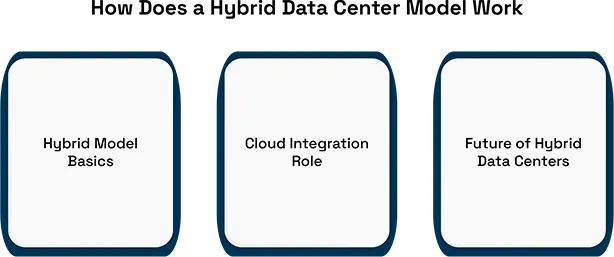In March 2025, the cloud integration model combined with hybrid data centers through the combined effect of artificial intelligence (AI) edge data centers, modular architecture, flexible, secure, and scalable IT requirements. More businesses now incorporate hybrid cloud solutions because they need the management benefits of traditional systems along with the speed benefits of cloud computing. Organizations can optimize their workloads and enhance data security functions, as well as maintain regulatory compliance through the strategic placement of defined data and applications across different environments. These models have been improved by Cloud computing data center services technologies, enabling organizations to conduct predictive resource allocation and manage systems proactively.

The combination of edge computing expansion with the IoT devices growth and 5G network deployment causes additional influence on hybrid cloud strategies. Businesses implementing data processing near their sources achieve better real-time decisions while also decreasing latency. The integration process demands powerful security measures, which drive organizations to implement zero-trust models for continuous user and device verification across all environments. The emerging hybrid cloud Hyperscale data center market stimulates organizations such as Equinix and Google data centers, along with Microsoft data centers and Nutanix and VMware, Broadcom and Amazon data centers, and Cisco data centers to optimize costs while implementing FinOps for expenditure management. Modern enterprises require hybrid cloud models because these developments make evident their critical role in meeting current organizational needs.
What is Cloud Integration and the Hybrid Data Center Model?
The Cloud integration describes how multiple Cloud computing data center services acquire connectivity to on-premises systems in order to facilitate smooth data flows with unified operational capabilities. This integration is difficult for businesses aiming to leverage diverse computing environments without compromising on performance or security. The hybrid Database center model embodies this integration by combining on-premises Colocation data centers with public and private cloud services, allowing organizations to dynamically allocate resources based on workload demands. This approach not only enhances operational agility but also provides a
strategic balance between control and scalability.
The hybrid model has evolved tremendously by 2025 through the addition of AI and machine learning and Virtual machines, which optimize resource allocations and forecast requirements. The updates in these systems help organizations maintain better response times for market adjustments and technology disruptions. Real-time decision-making capabilities now benefit from edge computing because this technology enables data processing at or near the data source to increase processing speed. IT infrastructures, together with DCIM (Data Center Infrastructure Management) systems, are evolving to become more adaptive through this trend, which supports the robust requirements of contemporary businesses.
How Does a Hybrid Data Center Model Work?
A hybrid data center model solution achieves its objectives through the combination of cohesive IT platforms, which unify on-premises systems with cloud-based infrastructure. The integration occurs through high-tech networking technologies, unified management platforms, and standardized protocols, which enable data and application transfers across different environments. For example, sensitive data can be stored and processed within a private cloud or on-premises facility to meet compliance requirements, while less critical workloads can be handled by public cloud services to take advantage of scalability and cost-effectiveness.
Containerization solutions with Kubernetes enhance hybrid model operational effectiveness because they let developers deploy applications with consistency on different platforms. AI-driven analytics functions as a key operational element for continuous system performance monitoring and future issue prediction as well as resource automation. The intelligent work management capabilities ensure both optimal cost efficiency and high-level service delivery that satisfies the requirements of digital business operations.

Why Do Businesses Need Cloud Integration?
Organizations need cloud integration during the modern digital age to maintain market competitiveness and adapt easily to shifting customer needs. Cloud integration serves as a critical tool for businesses that enables data communication between separate systems to optimize data asset value. The connectivity connects businesses for real-time analytics work as well as improved customer experiences along with innovating capabilities. Company operations today depend on integrated cloud platforms to run resource-intensive AI and machine learning applications at reduced financial costs.
Cloud integration helps organizations implement hybrid and multicloud approaches, which enable them to choose services from multiple vendors without being confined. Organizations gain flexibility when they use this approach to design their IT environment to fulfill distinct performance goals, security conditions, and regulatory criteria. Efficient cloud services integration enables businesses to operate with enhanced operational efficiency together with better departmental collaboration while speeding up their digital transformation projects.
Key Benefits of a Hybrid Data Center Strategy
A hybrid data center strategy brings multiple benefits that support corporate strategic needs in contemporary organizations. Pressing workload requirements become easier to handle by integrating cloud resources, which eliminates the necessity for major investments in physical infrastructure. Organizations benefit from fast market adjustments through flexible data capacity, which gives them enhanced control over changing business dynamics. A hybrid model enables organizations to protect themselves from disasters through distributed data storage, which minimizes data loss and helps maintain continuous business operations.
Cost optimization stands as a major advantage that organizations gain through this approach. Organizational workloads should be distributed between on-site and cloud-based operations to establish a performance-budget equity balance. The hybrid model enables companies to perform regular operations locally while shifting resource-demanding tasks to the cloud infrastructure network that supports flexible computing capabilities. Real-time insights become possible through edge computing integration in the hybrid model because it improves data processing efficiency and minimizes the need for time-consuming and expensive data transfer.
Challenges and Best Practices for Hybrid Cloud Implementation
Different issues need resolution for organizations to achieve full hybrid cloud capabilities during implementation. The main implementation challenge arises from the complex task of unifying different systems while achieving full-scale interoperability between local hardware networks and cloud-based platforms. The intricate nature of hybrid cloud implementation produces challenges that affect both data management operations and creates security risks and increased management complexities. Conducting security policy implementation becomes difficult across multiple environments because sensitive data requires strict adherence to different regulatory needs.
Organizations should develop an extensive plan that combines powerful security architecture with round-the-clock monitoring as their solution to address these difficulties. Organizations can enhance interoperability through standardized protocols together with advanced integration tools. The zero-trust security model gives continuous verification to all hybrid environment components, resulting in improved overall security posture. Training and development programs enable organizations to provide their IT staff with the necessary skills that allow effective management of complex hybrid infrastructure environments. Executing best practices gives businesses the capability to work through hybrid cloud complexities and reach growth along with innovation through best practices execution.







